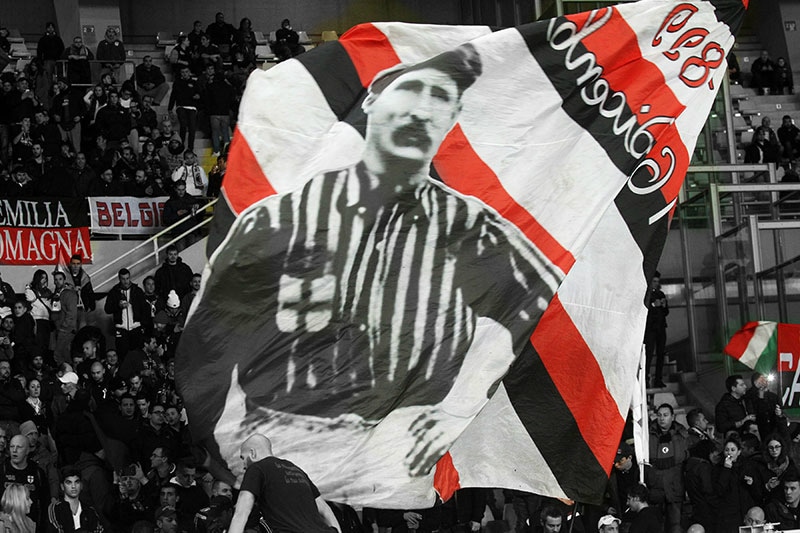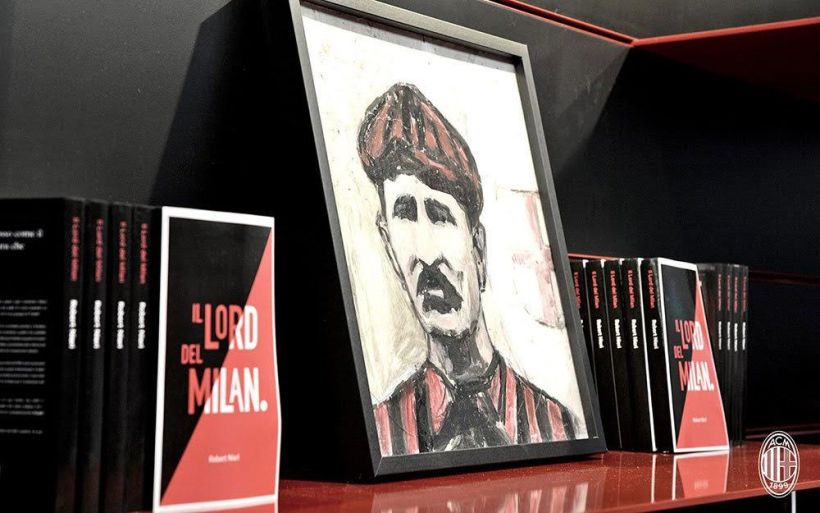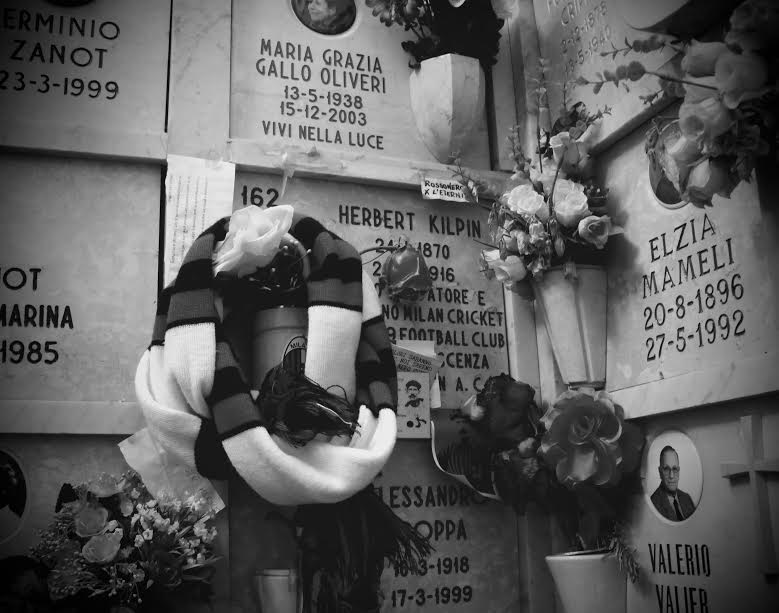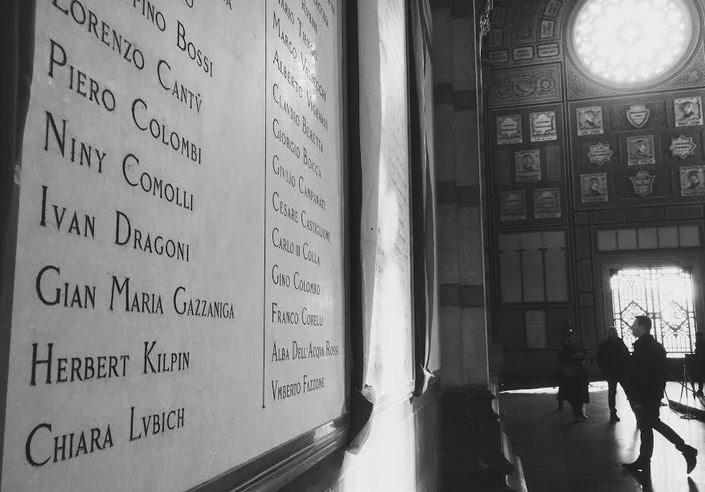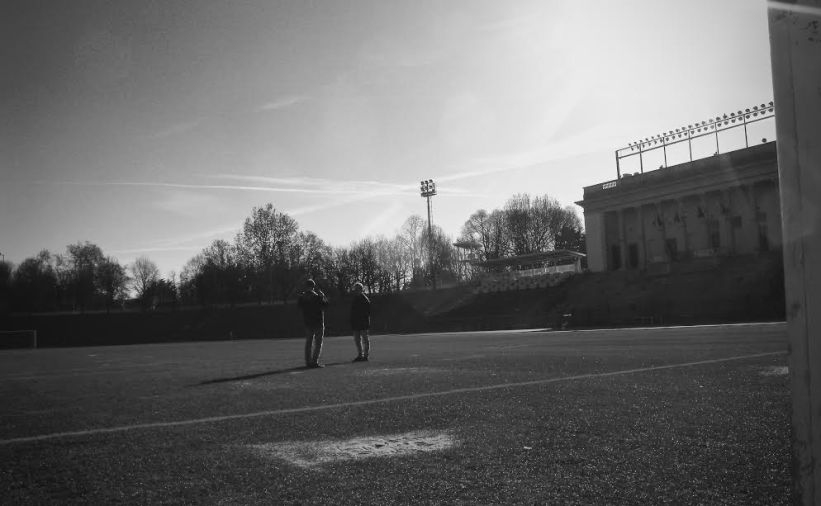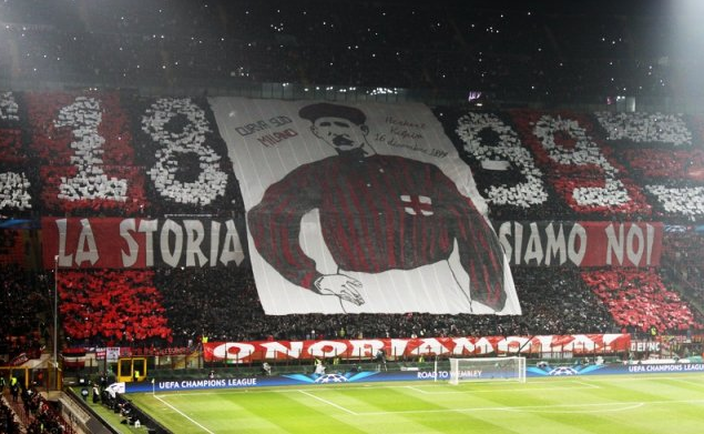James Kilpin returns to the table with a pint of beer in each hand. He slides one across the table to me. It catches a sticky patch, causing a little bit to splash out. James takes a first sip and settles in his chair. It is the spring of 2014.
‘Oh yeah, I meant to say, I’ve got some interesting news’, he reveals abruptly. I raise my eyebrows, mildly intrigued.
‘Go on’.
‘I’m related to the founder of AC Milan’.
I frown. ‘You’re what?’
James tells me the history. I sit back and listen intently.
‘William Kilpin, born around 1790, was Herbert’s great-grandfather. If you come down from him, you get to me after about six generations.’
And so Herbert Kilpin came into focus, and this journey began to take shape. James, and his brother Simon, wanted to discover their relative, to explore his past. They wanted to retrace the journey from Nottingham to Milan that Herbert Kilpin began as a 21 year old with a thirst for adventure. James and Simon were not content just using their link to AC Milan as an eyebrow-raiser in the pub.
‘We thought about flying straight to Milan and seeing the sights there’, James explains, ‘but the best way is to go and see where the story begins, where he was born, where he lived, where he worked in Nottingham… It’s important to us to understand the story in its entirety.’
The portrait of Kilpin is of a pioneer, a maverick. The ninth child of a Nottingham butcher, he formed Milan Foot-ball and Cricket Club in 1899. The nascent Rossoneri won three titles in the following decade. Kilpin was the main man, the exporter and the master. He notoriously swigged whisky before and after matches, to celebrate victory or numb defeat. Yet he still managed to play until the age of 43, longer than the evergreen Paolo Maldini. A photograph of Kilpin in his match kit reveals an austere, moustachioed figure. He wears a button-up red and black shirt, with a starched collar, and a flat cap. It is a dashing look. He nonchalantly dangles a cigarette between the fingers of his left hand.
Despite his intriguing character, the paint on Kilpin’s portrait faded. Until 1999, he lay in an unmarked grave. He had been forgotten, lost in the mists of time. Only recently, a little over 100 years since Kilpin’s death, is he returning to prominence. There is enough paint on the faded portrait to see an outline of the enigmatic figure.
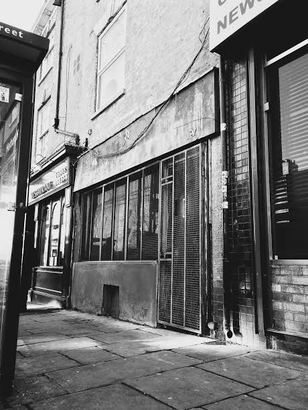 191 Mansfield Road (Image: Matt McGinn)
191 Mansfield Road (Image: Matt McGinn)
So here we are, on Mansfield Road, Nottingham. A steady flow of buses heave up the incline from the city centre. An acrid trace of engine fumes hangs in the air. A skittish man leans against the haggard brickwork of number 191. His baseball cap is downturned, but not enough to cover his eyes, which dart as if watching a ricocheting pinball. He mutters something about the government under his breath, and scurries off down the hill.
A collection of stickers on a drainage spout betrays the significance of 191 Mansfield Road. Herbert’s face, silhouetted in red and black like that Che Guevara image, gazes down. Herbert Kilpin was born here on 24 January 1870, the ninth child of Edward and Sarah.
The dilapidated house has been unoccupied for years. In its most recent incarnation, it was a halal butcher, the same trade for which it was known in Kilpin’s day. The shop sign was once blue. The paint is peeling away to reveal an anaemic metal base. A grill protects the window, opaque after years of dust accumulation. The inner-pane of an upstairs window is smashed.
The 87 bus pulls into the stop in front of the house. It drops someone off, and continues to Arnold. We ask about Herbert Kilpin in the grocery shop next door. The cashier meets our question with a shake of the head and a nervous smile that indicate he has no idea what we are talking about.
The scene on Mansfield Road was incongruous. To us, it was a destination, a place of significance. To everybody else, unaware of Kilpin, it was an eyesore. Little is known of Kilpin’s life in Nottingham. Apart from his place of birth, the only certainty is that he worked in the Thomas Adams lace warehouse. In industrial Britain, Manchester was known for cotton, and Macclesfield for silk. Nottingham was the home of lace production.
Lo Sport Illustrato, an Italian newspaper, published a collection of anecdotes written by Kilpin in February 1915. According to these, Herbert was a keen footballer from the age of 13, when he played as a right-winger in his first match at the Forest Recreation Ground. Even as an adolescent, he was a budding Italianist. That day, he wore the red shirt of Garibaldi, a youth team he had founded in recognition of the Italian nationalist. The young Herbert also represented Notts Olympic and St Andrews in the second division. The scraps of information that do exist about Herbert’s time in Nottingham indicate a football obsessive.
At the Forest Recreation Ground, school teams now compete for The Kilpin Cup. Nottingham is belatedly engaging with the story of its emigrant son. A commemorative plaque will soon hang from the wall of 191 Mansfield Road. LeftLion, a Nottingham-based media company, will premiere a feature-length documentary on Kilpin’s life, in 2017.
We stroll back along Mansfield Road, past a succession of takeaways, pubs, and bookmakers. James and Simon, who grew up in Buckinghamshire, discovered the familial connection in 2013. They were aware that the founder of AC Milan shared their surname, but the genealogy did not stack up. They could not immediately establish the link to Nottingham. ‘The Kilpins have been in Buckinghamshire as long as anyone knows. The joke is that we’ve never left.’
It was Herbert’s father, Edward, who left Stoke Goldington, Buckinghamshire for Nottingham in search of a better life in the city. Stoke Goldington has since acquired a new city on its doorstep: Milton Keynes, which celebrated its fiftieth birthday in January 2017.
The takeaways, pubs, and bookmakers give way to the brutalist exterior of the Victoria Shopping Centre. We had re-entered the city centre bustle. We cut through The Major Oak, a pub that straddles Pelham Street and Victoria Street. A stern portrait of Herbert Kilpin hangs on the wall. The lights from a fruit machine flicker on its glass frontage. A couple canoodle on a sofa below.
We follow Victoria Street until it curves in to Fletcher Gate, where the trams rumble and ding up the hill. The Lace Market is to one side of the tram tracks, a maze of narrow streets between red brick warehouses. Within it, lies the Thomas Adams building, where Kilpin worked. We had retraced Herbert’s walk to work. It would have been at the Thomas Adams building where Kilpin met Edoardo Bosio, a textile merchant from Turin. In 1891, Bosio facilitated Kilpin’s passage to Italy.
We dart off Fletcher Gate in to a narrow alleyway. The alleyway opens out into a courtyard. There stands The Herbert Kilpin pub. A Kilpinian moustache sits atop the pub’s minimalist sign. We order pints of Kilpin Pale Ale. It would be churlish not to. ‘That’s just bizarre’, chuckles James, shaking his head, ‘Kipling is everywhere; Rudyard, Mister, but you never hear the name Kilpin.’
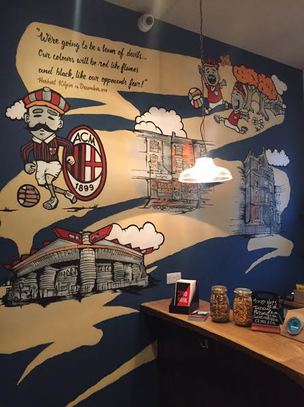 The mural at The Herbert Kilpin Pub traces the journey of ‘The Lord of Milan’ (Image: @lordofmilan)
The mural at The Herbert Kilpin Pub traces the journey of ‘The Lord of Milan’ (Image: @lordofmilan)
A colourful mural crawls up the wall beside the bar. In terms of symbolic importance, 191 Mansfield Road stands beside San Siro. It perfectly encapsulates the allure of the story of Herbert Kilpin. An extraordinary club emerged from ordinary origins.
We have come to The Kilpin to meet Robert Nieri, the Nottingham man who has recently written ‘The Lord of Milan’, a book about Herbert’s life.
Robert stumbled across the story nine years ago. ‘There was a headline in the newspaper [The Nottingham Post] saying this local man had founded AC Milan, and I just thought that was amazing.’ He began to research immediately. Yet information was not forthcoming. There is minimal information about Kilpin’s life.
‘I was writing it as a biography but there wasn’t enough information, so I fictionalised bits,’ Robert tells us.
This change of direction, advised by Brian Glanville, denizen of football writing, moulded Nieri’s work in to its current form; a work of fiction inspired by fact. Nieri, a lawyer, used a combination of Kilpin’s anecdotal memoirs, match reports, and obituaries to shape the character of his protagonist.
‘Although it is fiction, I think he’s pretty close to the truth. I lived with him for nine years, and his story marinated in my head’
His resultant presentation of Kilpin is not panegyric.
‘I don’t think he was a very sympathetic figure in many respects. I think that’s because he was a bit of an obsessive, a bit autistic really.’
To qualify his intuition, Robert retells one of the anecdotes that Kilpin regaled in Lo Sport Illustrato, in 1915. On his wedding night in 1905, Kilpin received an invitation by telegram to play a match in Genoa the following day. He promptly left the next morning, reminding his new wife that he had only agreed to marry her on the understanding that she would not prevent him playing football.
The pub, which pulled its first pint in 2016, vibrates with Friday night energy. We talk above the patter of chatter, clinking of glasses, and outbursts of laughter. The joint-owner, Nigel Garlick, sits down at the table. More and more people pull up chairs to join. The topic of conversation dances between (Nottingham) Forest, (Notts) County, and Kilpin.
Robert was initially frustrated by the gaps in Kilpin’s story. Now, he embraces them, and the creative freedom they gave him.
‘Lace, the product that defined Kilpin’s hometown in the industrial age is special because of what is not there. It is just another piece of cotton if you fill in the gaps.’
The Forest Recreation Ground, where Kilpin represented Garibaldi, once formed the southern extremity of Sherwood Forest, the alleged refuge of Robin Hood and his Merry Men. Nottingham and legend are natural companions.
I ask Robert how AC Milan have received his book, which was released in conjunction with the centenary of Kilpin’s death in October 2016.
Robert mentions Marco Amato’s name frequently. The launch took place at the club thanks to the interest of Marco, the curator of the AC Milan club museum. He is a spark of engagement. He strives to educate Milan fans about the history of the club. Apart from a number of die-hard Milanisti on the Curva Sud, even in Milan, Kilpin remains largely unknown.
As we finish the dregs of our Kilpin Pale Ale, it becomes clear that there are two separate strands within our trip along the Kilpin trail. The first is the story of Herbert Kilpin. Or, at least, what is known of it. The second is the story of those, like Robert Nieri, who have breathed life into Kilpin’s story.
Click to order a copy of ‘The Lord of Milan’, by Robert Nieri.
Marble gargoyles stare down from the Duomo di Milano. There is a throng of selfie-stick salesmen and pigeons in the piazza below. The cathedral is a magnificent structure, intricate yet vast. It is the largest church in Italy. The start of a 579-year construction project coincided with the rise to power of Gian Galeazzo Visconti, whom a plaque on the side of the cathedral refers to as ‘The Lord of Milan’. He sought to create an iconic structure, and thus ordered that the cathedral be clad with marble, as was the contemporary style in French architecture.
It is easy to draw parallels between the two men who share the ‘Lord of Milan’ title, Kilpin and Gian Galeazzo. The stout, concrete coil legs around San Siro give it the appearance of a vehicle that has landed from another planet. Both men created something enduring and striking. Kilpin passed away long before the construction of San Siro. But it is his legacy.
After he left Nottingham in 1891, Kilpin initially settled in Turin. Edoardo Bosio, Kilpin’s contact in Italy, had established his own textile factory in Piedmont. Kilpin’s expertise were a valuable commodity in Northern Italy as the region underwent rapid industrialisation. Bosio discovered football during his time in Nottingham. He took to it instantly. Upon his return from England, allegedly with a leather ball under his arm, Bosio formed Internazionale Torino, the first club on the peninsula. Kilpin and Bosio played with each other for several years; English master alongside Italian pupil. In doing so, Herbert became the first known Englishman to play for a foreign team.
Kilpin moved to Milan, the engine of Italy, in 1897. He continued to return to Turin to play football at the weekends, but was concocting a plan of his own in his adopted city.
Milan Foot-ball and Cricket Club was founded on 16 December 1899, in a room at the luxurious Hotel Du Nord et des Anglais. Kilpin invited Alfred Edwards, the Vice-Consul in Milan, to be the first President. Kilpin recognised that he needed Edwards’ web of diplomatic contacts. Although Kilpin was the most experienced player, he elected David Allison, a Mancunian, as captain. Herbert did not assume an official position at Milan, yet he still pulled the strings.
We are at AC Milan’s striking new headquarters in the north of the city, Casa Milan. It juts out from the ground, a hulk of glass and metal. Meanwhile, we absorb the winter sun.
‘Kilpin?’, enquires a heavily-accented voice.
Luigi La Rocca extends a warm handshake and a grin spreads from beneath his thick moustache. Luigi is dedicated to delivering posthumous recognition to Herbert Kilpin. In 1998, he found the unmarked grave of Kilpin in Cimitero Maggiore in Musocco, a vast municipal cemetery to the north west of Milan. He was in a section reserved for protestants, erroneously registered as ‘Alberto’ Kilpin, the Italianised version of his name.
‘There was only a little box, without a name, only a number’, Luigi says in a voice turned gruff by Italian cigarettes, ‘I hoped to find something of AC Milan in his grave, but I found nothing. There were only the bones.’
A hip flask would have been a fitting personal affect. Nevertheless, it was an emotional moment for Luigi. ‘I touched the founder of AC Milan, and I will remember that for the rest of my life’, he says earnestly.
After this seminal discovery, Luigi lobbied AC Milan to move Kilpin to a location befitting of his status. He succeeded.
We weave between the traffic in Luigi’s white four-by-four. Herbert Kilpin occupies a modest position in a magnificent building. The Monumental Cemetery was originally designed as a church, and is accordingly striking. It is now a sepulchre for the most distinguished Milanese figures. Kilpin’s grave is in an alcove, half way along a serene corridor. It is silent, but for the whir of the electronic lighting and the sound of our own footsteps. The vault is small, little bigger than a shoebox. Yet it had clearly attracted visitors. A shrivelled red rose perches within the folds of a Milan club scarf. Someone had slipped a scrap of paper in the crack around the side of the vault. It has a phrase written on it in black ink:
Our colours will be red, because we will be the devils, and black, signifying the fear we will strike in to the hearts of our opponents.
Herbert Kilpin’s grave in Milan’s Cimitero Monumentale (Image: Matt McGinn)
Legend dictates that this Kilpinian quotation is the reason that AC Milan play in red and black.
James and Simon read the messages that had been left by Milanisti, from as far afield as Russia.
Luigi breaks the silence, ‘I don’t like this location personally, I prefer another grave.’
We exchange surprised glances as Luigi leads us back along the corridor. He walks up a short flight of steps into the Famedio, The Temple of Fame. It is the centrepiece of the cemetery, a stroll through the cultural history of Milan. The great and good of the city rest beneath an extravagant domed roof. It is a rich shade of blue, and studded with crystals. The grave of Giuseppe Meazza is in an adjoined crypt. The official name of San Siro is ‘Stadio Giuseppe Meazza’, a tribute to a player who represented both Milan and Inter, and Vittorio Pozzo’s dominant Italian team of the 1930s.
‘I hope to move him to this bit’, explains Luigi, ‘but it is difficult. Not because of money, but because it is a political decision.’ He cuts himself off. ‘And now, my masterpiece!’, he trumpets with a beaming smile.
There are three marble plaques attached to a sidewall in the Famedio. A list of Italian names is inscribed in block capitals. They are, according to the heading, the illustrious and distinguished citizens in the history of the nation. Herbert Kilpin is among them. Luigi chuckles to himself, as if mildly disbelieving of his achievement.
As we descend the steps at the front of the Famedio, I ask Luigi how most Milan supporters view Herbert Kilpin. ‘Ahh, the younger supporters don’t know who Herbert was, but without him… No Milan.’
He cups his hands around a cigarette. He is poised to light it, but continues talking as it droops out of his mouth. ‘The young supporters probably don’t know who Franco Baresi was’, he muffles, ‘they are not interested in the history of the club.’
A picture of Herbert’s place in contemporary Milan was becoming clear. A passionate minority venerate him. To the majority, he is just the face on a flag that sometimes flies at San Siro.
Herbert Kilpin’s name inscribed on a plaque in Famedio (Image: Matt McGinn)
There was one more place that Luigi wanted to show us. The medieval castle is the main attraction in Parco Sempione, a five-minute drive south from the Cemetery. It also contains the Arena Civica, unveiled by Napoleon in 1807 in the style of a Roman amphitheatre. Luigi has a word with a security guard, and leads us on to the pitch.
‘In this ground Kilpin played… played football and drank whisky,’ Luigi announces.
‘This is incredible’, Simon remarks, ‘it doesn’t look like anything has been done to it.’ Only the fibreglass dugouts betray that we are in the 21st century. Two men in their twenties amble to the centre circle. One has a crocodile-skin holdall slung over his shoulder. ‘Brera’ is stitched in to the bag. The Arena Civica is now the home of lower-league Brera FC, named after the eminent Italian journalist, Gianni Brera.
The Arena was once filled with water and used to recreate a naval battle. In July 1986, Silvio Berlusconi choreographed a similarly extravagant show. Three black helicopters fluttered on to the pitch as Wagner’s ‘Ride of the Valkries’ reverberated through the speakers. One-by-one, the Milan squad stepped on to the pitch. The last man to emerge was Silvio Berlusconi. It was an act of Apocalypse Now-inspired showmanship by Berlusconi, who sought to inaugurate his ownership of Milan with a decadent statement.
There is a dichotomy between the unashamed decadence of Berlusconi, and the perceived wholesomeness of Kilpin’s era of gentlemanly football. A small group are acutely aware of this. Kilpin has become an anti-Berlusconi figure. He occupies a symbolic, nostalgic space that grows in parallel with commercialism in football.
In 2005, ‘La Banda Casciavìt – Herbert Kilpin Firm’ emerged from various groups within the Curva Sud. It seeks to disseminate the history of Herbert Kilpin, and AC Milan. The group often display a banner at San Siro; a cartoon figure of the moustachioed champion whose memory they cherish.
The group issued a revealing statement in 2006, on the 90th anniversary of the death of Herbert Kilpin. It admonished AC Milan, ‘more attentive to celebrate the 20th anniversary of the president than the centenary of its history or historical figures.’
‘La Banda Casciavìt’, which translates, rather ominously, to ‘The Screwdriver Crew’, stressed that the club did not start in 1986, when Berlusconi bought the club, but in 1899.
The group declared itself to be ‘tired of this modern football, increasingly dominated by business and ‘the present’, which forgets its history, its origins.’
This presents an interesting paradox. As fans grew disillusioned with their club, they found solace in its founder. Perhaps their veneration of Kilpin is an attempt to reach the heart of what football is; a reaction to a sense of detachment from its present form. In football, yesterday is often deemed better.
Arena Civica, the ground where Kilpin played and drank whisky. (Image: Matt McGinn)
Kilpin played his final match for Milan in 1908. He hung up his boots after 23 appearances, seven goals, and three championships. Yet cracks were appearing in his creation. That same year, the Italian Football Federation banned foreign players. This decision was a product of a clash between gymnastic clubs that sought to emphasise the Italian identity of football, and the perceived Anglomania of football clubs. A schism formed within the club. A band of foreign players split, and formed Internazionale. Milan did not maintain the success of their first decade. By the time they won another domestic title in 1951, Fascism had come and gone.
Kilpin slipped into obscurity. He had married an Italian lady, Maria Capua, in 1905, but they left no children. The internal strife at Milan must have bruised him, but he continued to steadfastly support his team from the touchline. Obituaries uncovered by Robert Nieri portray Kilpin as an introverted retiree. He watched Milan’s matches alone, with his hands burrowed in his pockets. He appeared to be in his own world.
He died in October 1916, at the age of 46. It is probable that his fondness for whisky and cigarettes caused his death, but it is difficult to say with certainty. Tributes to Kilpin were generous. ‘A magic name’, gushed Lo Sport Illustrato, ‘a name which encapsulates the history of football’. The iconic pink-paged paper, La Gazzetta dello Sport, declared that ‘the pioneer of Italian foot-ball has died’.
The glow from streetlights reflects off the Naviglio Grande canal on our last night in Milan. It is the Bacchanalian centre of the city. Fur-clad people with pronounced cheekbones sip cocktails made with Campari, and pick at plates of cured meat and cheese. Naviglio Grande is one of the few remaining canals in Milan. Mussolini turned the majority in to roads as part of his modernisation programme. The three of us settle in a bar to discuss the journey. David Bowie songs play out through the speakers.
In 2013, the Curva Sud, Milan’s most passionate section of support, choreographed a grandiose display of Kilpin’s face before a Champions League match against Barcelona. The phrase ‘La storia siamo noi’ (‘we are the history’) accompanied it. The display exaggerates Kilpin’s importance to Rossoneri fans. He is not a prominent figure in Milan.
I wondered whether this had surprised James and Simon. ‘It’s sort of what I was expecting’, James replies, ‘I didn’t expect everyone to know who he was, that would be unrealistic.’
‘I didn’t realise the national significance of it’, Simon muses as the ice from his glass of beer forms a puddle on the table, ‘Luigi and that group see him as the father of Italian football. There’s a debt of gratitude [to Kilpin], football is something that has made Italy a proud country.’
‘Honour him’ – the Curva Sud Milano’s tribute to Herbert Kilpin
The brothers feel their own debt of gratitude to Luigi La Rocca.
‘It’s amazing to see Luigi take it on as his pet project. To see something and go, ‘well that’s not right’, and then not stop until what he sees as an injustice being rectified.’
James nods in agreement with his older brother, ‘the difference between an unmarked grave and there now being a place where people can leave stickers, cards, and scarves, is incredible.’ He pauses for thought. ‘Luigi feels like he has got his foot in the door, but can now do more. He wants Herbert to have a place amongst the sporting greats.’
In Milan, the story of Herbert Kilpin still flows underground, like the canal network that once resembled Venice. It is the preserve of a small group of dedicated supporters. Yet the story is emerging and gaining momentum. Luigi strives for greater recognition; he is campaigning to move Kilpin to the Famedio, alongside Giuseppe Meazza, both physically and symbolically. In Nottingham, Robert Nieri wants to project Kilpin’s story on to the cinema screen. He has sent a copy of the book to Danny Boyle, albeit more in hope than expectation.
This is the story of a familial connection. The small group of Kilpin enthusiasts welcomed James and Simon with warmth. They were delighted to share their knowledge. Football can show the worst of human nature, but also the best. We visited the club museum the day before we left, which was also the day before Herbert Kilpin’s 147th birthday. Marco Amato, dressed impeccably in a tweed jacket and slim red tie, gave us a tour of the museum he curates. After, he said goodbye to the Kilpin brothers.
‘I hope to see you again, this is your home here.’
Words by Matt McGinn: @McGinn93

